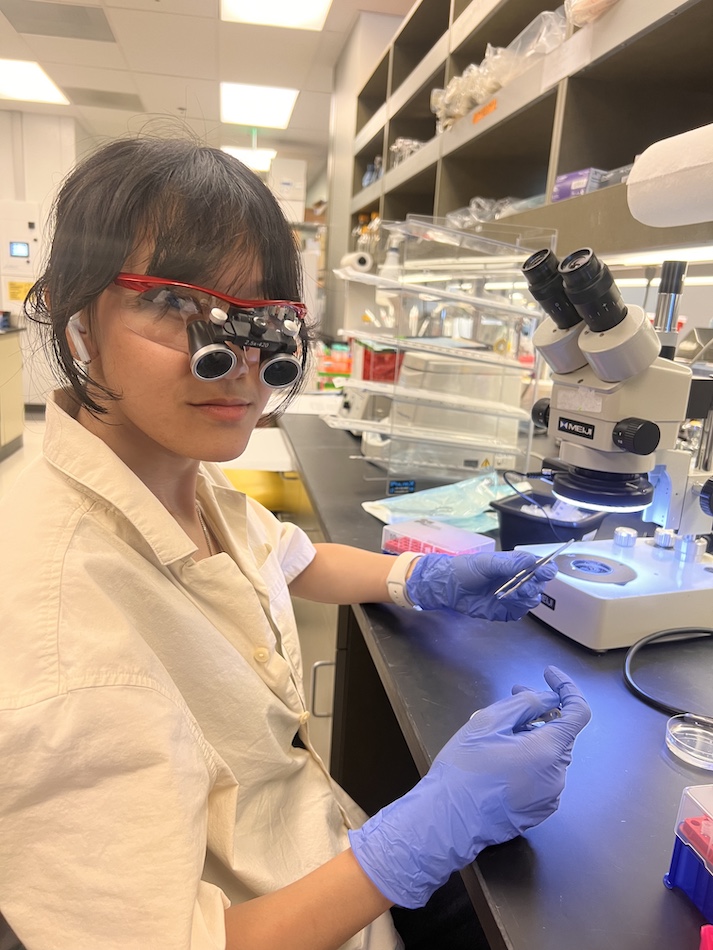Gregory Seumois, Ph.D., applies advanced genomic tools to better understand the molecular and cellular mechanisms of asthma. Already, his work has advanced how immunologists worldwide harness genomic data in their research.
As a postdoctoral research at La Jolla Institute for Immunology (LJI), Seumois worked closely with LJI Professor Pandurangan “Vijay” Vijayanand, M.D., Ph.D., and Research Assistant Professor Benjamin Schmiedel, Ph.D. to establish the NIH-funded Database of Immune Cell Epigenomes (DICE), a powerful, open-access database for better understanding how gene expression drives immune cell function. For the last 9 years, Seumois also supported sequencing efforts for the NIH’s Human Immunology Project Consortium (HIPC), working closely with LJI Professors Bjoern Peters, Ph.D., and Alessandro Sette, Dr.Biol.Sci.
But Seumois’ work is not just about supporting others. Over the years, Seumois has leveraged his collaborations to build an innovative and ambitious program of research to study asthma and respiratory allergies.
Now Seumois has been awarded NIH funding (R01 and R21 grants) and has been promoted to Research Assistant Professor at LJI, which opens up new opportunities for him to receive independent funding, hire lab members, and assemble his own laboratory at the Institute. In this Q&A, Seumois shares how this major career step will fuel vital research into asthma and respiratory allergies.
Q: What motivated you to focus your career on combining genomic sequencing and immune system research?
A: During my Ph.D., I studied apoptosis, or cell death, of granulocytes in the context of asthma. These cells have their own molecular program to self-destruct. I found it fascinating how they sacrifice themselves in the battle against pathogens. However, this process is a big part of the problem during asthma or respiratory allergic crises, where there are no pathogens and therefore no reasons for granulocytes to react at all. This sparked my interest in studying molecular human immunology.
For my Ph.D., I went on to study human immunology at the University of Southampton (UK), where I first met Vijay. We started to explore how epigenetics can regulate cell fate in the context of asthma. Basically, we wanted to know how genes are regulated based on epigenetic changes. How are diseases influencing epigenetic conditions of cell function or gene expression?
As we continued our scientific journeys, we found ourselves riding the wave of the genomic revolution, which has dramatically transformed biomedical research in the past decade. Today we can measure expression of more than 30,000 genes at individual cell resolution—which is just amazing—and this is just the beginning. Our pioneering work involved applying those fascinating techniques to human lung samples first in relation to asthma and allergies, and then with other important diseases such as cancer and CoVID-19.
What are you looking forward to in this new position as Research Assistant Professor?
I’m looking forward to growing as a principal investigator as it presents an opportunity for personal and professional growth. As a Research Assistant Professor, I am eager to lead my own team and independently develop impactful projects.
I’ll still be keeping a very strong collaboration with Vijay, as I believe tackling significant health challenges in science and research is best approached as a cohesive but multi-disciplinary group. And the environment at LJI is exceptional and further enhances this prospect.
What kind of expertise are you looking for as you build your team here?
In my lab, first I’ll keep applying genomics analysis to identify new clues—such as new molecules or new cells involved in the development of asthma or respiratory allergies. I seek smart and curious individuals who are committed to pushing the boundaries of research beyond traditional working hours. I want to implement a highly collaborative and open communication mindset in my lab and will focus on mentoring and supporting the growth of young and enthusiastic researchers. Together, we will strive to advance human immunology and hopefully make a meaningful impact on patient care.
Are there any lessons you’ve learned from Vijay that you want to share with your new lab members?
Absolutely! First off, it’s all about keeping a positive and optimistic attitude. Our projects are challenging, and we need to approach our duty with intensity and focus on delivering top-notch quality. At the same time, it’s important to give time to develop creativity, to think outside the box.
Secondly, don’t let negative results get you down. In science, we’re bound to encounter setbacks along the way. But here’s the thing, there are no setbacks, only wrong interpretations, or contextualization of the results! It’s important to learn and transform setbacks into success. That may require a lot of work and certainly a flexible mindset, but it is essential. Finally, perseverance is key!
You mentioned that LJI is a good place to do your research. Are there any certain facilities or equipment that you find especially useful at the Institute?
Right now, we are using the Flow Cytometry Core a lot. It’s outstanding, probably the best one on the West Coast. The core is not only exceptionally well equipped with several cell-sorters and analyzers but more importantly, Core Director Cheryl Kim and her team are extremely knowledgeable, skilled, and flexible. They understand that experiments can sometimes take longer than anticipated, and their support in experiment design and data interpretation is invaluable.
We also work with the Department of Laboratory Animal Care (DLAC), which provides fantastic support for our testing and functional analysis. Although we take care to reduce our work with animal models, DLAC remains a crucial facility to allow us to explore how our genomics discoveries can be translated to the diseases we study.
Then we are also in very close contact with Director Suzie Alarcón from the Next Generation Sequencing Core, and we are very interested in working with Kenneth Kim, Dipl. ACVP, from the Histopathology Core and Zbigniew Mikulski, Ph.D., from the Microscopy and Histology Core to delve into the realm of spatial transcriptomics. This innovative technique bridges the gap between linear genomic sequencing analysis and microscopy, providing us with a more comprehensive understanding of cellular interactions within tissues.
We’re glad you’re continuing this work at the Institute!
I feel very fortunate to be part of LJI! I think the Research Assistant Professor track is a fantastic initiative to promote and foster the young talents that grew up and trained within our institution.


